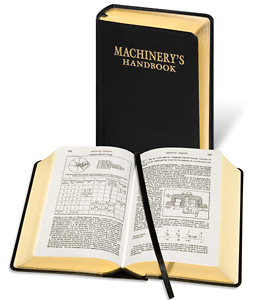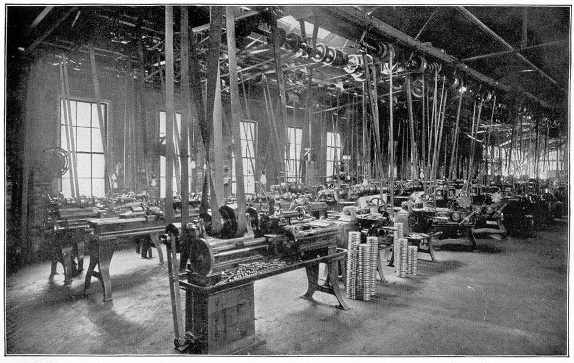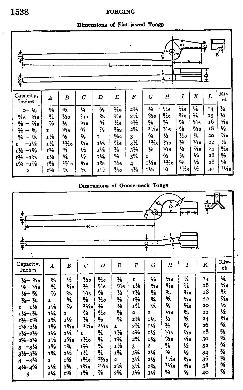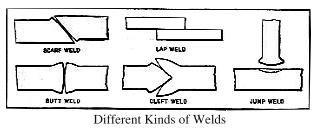|
|
|

|
Industrial Press
Machinery's
Handbook
First Edition Reprint - 2008
Commerative Reprint Celebrating 125 years of Machinery's
1400 Pages, B&W size 5 x 7-1/8 x 2-5/8 inches (127 x 181 x 67 mm) with gold edging
|
Book Review by Jock Dempsey
Machinery's magazine
had been in publication for 20 years when the editors at Industrial Press decided to put their accumulated articles and wisdom into one book.
To their distilled articles they added common mathematical tables, data from CRC (Chemical Rubber Company) who had just published their first handbook in 1913,
SAE (Society of Automotive Engineers) established in 1905, and many other sources. Audel's Engineers and Mechanics Guide, a 12 volume set, would not be published until 1921.
Much of what was combined into the Handbook replaced a library of mathematical, chemistry and physics books as well as catalogs and booklets like
The Starrett Book for Machinists' Apprentices (1915).
 When the First Edition was Published in 1914 most shops still had long lines of overhead shafting and its web of belts, machinists still hand forged, hardened and tempered their lathe cutters, the slide rule was the foremost calculation device in engineering offices.
Motive power was most commonly supplied by steam engines.
Forge welding was still common in the shop and riveting rather than welding was used to make bridge beams, ship hulls and airplane fuselages.
Oxy-acetylene was in use but the portable acetylene cylinder which had just been invented was not in wide spread use.
The automobile was still a curiosity in most places. It was still largely the horse and buggy era.
When the First Edition was Published in 1914 most shops still had long lines of overhead shafting and its web of belts, machinists still hand forged, hardened and tempered their lathe cutters, the slide rule was the foremost calculation device in engineering offices.
Motive power was most commonly supplied by steam engines.
Forge welding was still common in the shop and riveting rather than welding was used to make bridge beams, ship hulls and airplane fuselages.
Oxy-acetylene was in use but the portable acetylene cylinder which had just been invented was not in wide spread use.
The automobile was still a curiosity in most places. It was still largely the horse and buggy era.
The fact that all the information from the first edition of Machinery's Handbook still holds up to the test of time is amazing.
The Changing World
In 1914 World War I begins.
The Panama Canal is officially opened after 10 years of construction.
Theodore William Richards was awarded the Nobel Prize in Chemistry "in recognition of his accurate determinations of the atomic weight of a large number of chemical elements".
Einstein had concieved his theory of relativity but would take another two years to perfect it and another three to have it proved.
On February 26, 1914 the White Star Line passenger vessel R.M.S. Britannic launched as a sister ship of the R.M.S. Titanic that went down in 1912 but with modifications designed to make her truly unsinkable.
On February 27, 1914 the Ford assembly line in the new Highland Park plant for the construction of the whole automobile was complete and tested.
The highly skilled craftsman and machinist was being replaced by the machine and even more highly skilled tool and die makers and improved machines.
In 1916 the United States Road Aid Act was passed which developed the famous U.S. 1, 40 and Route 66.
Big engineering projects were the sign of the times. And in this tumultuous year MACHINERY'S HANDBOOK was born.
The Content
The first chapters are on mathematics and include the age old log and trig tables that have been made redundant by pocket calculators.
Then there are the VERY useful trig formulas and solutions to triangles with diagrams and examples, the area and volumetric equations and the section properties formulas.
All are illustrated and include examples of how they are used.
As a machine designer I have referred to this section often.
As a machine reference Machinery's includes information on everything from cutter bit materials and shapes, standard slides (ways), shafting ratings and critical speed formulae to name a few.
There are sections on how to use a dividing head, gearing and pulleys.
Small tools specifications are given for drills, standard tapers, taps, dies, reamers, countersinks and many more.

For Blacksmiths there are many things of interest besides the steel and heat treating information.
Up until the 22nd edition this standard tong dimensions chart was in the section on forging.
Other blacksmith specific items included a brief article on anvils, the air needed to supply multiple forges, ratings of steam and power hammers and hammer foundations.
Over the years these articles were shortened and made briefer and briefer then eventually dropped.
Other items of interest to blacksmiths are sections on babbitting, welding, Thermit (better in the older editions), weights of bar, chain and fasteners.
There are formulae for deflection under load.
The last sections of Machinery's is drawing and standards oriented.
There are charts of conversion units for weights and measures.

Forge welding scarfs were the standard when the 1st edition was published and the chart above (right) introduced the welding section until at least the 15th edition.
The Reprint
Over 104 years had passed since Machinery's Handbook first appeared.
Editors and their personal libraries have come and gone.
Along with them all copies of the first edition.
To produce the reprint the editors had to go out into the current collectors market and purchase a copy.
I had purchased a 1914 third edition and offered it and a copy of first edition title and preface pages for the reprint but the editors held out.
The reproduction has a soft leatherette cover the same as the original and modern mylar gold leaf edging and stamping.
It is nearly identical in production to the original as possible with the exception of the use of gold ink on the cover instead of stamped gold leaf as on the originals.
Includes protective reusable box.
Trivia -- Did you know that the small center drawer found in almost every machinist's tool chest was designed to fit Machinery's Handbook?
The 1914 Editions
The Editors at Industrial Press had no idea how successfully the Handbook would be.
The first printing of 10,000 titled First Edition was sold out in the first month.
Second through fourth printings were produced in 1914 and subsequently titled "editions" even though the
only change was the title page (declaring the printing an "edition") and preface (commenting on the continued success).
The fifth edition (printing) was the same as the First Edition and produced from 1915 to 1923.
Roughly 225,000 copies were sold in the first decade of Machinery's Handbook.
|
|
| Early Editions |
| Edition |
Printing Date |
Quantity |
Printing |
Pages |
| FIRST |
1914 |
January |
10,000 |
1 |
1400 |
| SECOND |
February ? |
5,000 |
1 |
1400 |
| THIRD |
April |
6,000 |
1 |
1400 |
| FOURTH |
December |
5,000 |
1 |
1400 |
| FIFTH |
1915 May |
200,000+ |
10+ |
1400 |
| SIXTH |
1924 January |
??? |
? |
1599 ? |
|
The Tables
There is an interesting history to the creation of Logarithm tables.
The reason they are reproduced over and over in many references is that they are VERY difficult to calculate.
Their use was discovered by the mathematicians Jobst Bürgi and John Napier at the beginning of the 17th century.
Napier is famous for the development of the slide rule (jokingly called Napier's bones) and is considered the father of logarithms.
Then the work on calculating the tables was started.
But even world class mathematicians could take days to calculate one.
In 1840 Schulz von Strassnitzky discovered an "idiot savant", Johann Dase who could do unbelievably complex calculations in his head very quickly.
Strassnitzky taught Dase a formula for calculating logarithms and in 1844 to 1847 Dase calculated
the first 1,005,000 natural logarithms each to 7 places.
In 1847 to 1849 he also calculated a table of hyperbolic functions.
Carl Friedrich Gauss recommended to the Hamburg Academy of Sciences that they support him while he calculated mathematical tables.
He started calculating factors of numbers from 7,000,000 to 10,000,000 but died half way through in 1861.1
These high accuracy factors were used for manual calculations for over 100 years.
While slide rules were common they needed log tables for accuracy in handling large numbers or where many decimal places are important.
The many tables published in the handbook were painstakingly calculated by hand, checked by hand and typeset by hand.
It took the modern digital computer to replace these "common" tables and the slide rule.
Meanwhile, for over 100 years the greatest engineering feats of mankind relied on the work of a long forgotten "idiot" or what we would call today "a person of special needs".
These feats included the building of some of the world's most famous dams and bridges, landing a man on the moon and the construction of many nuclear power plants.
Power plants which are now run largely by computer were built using the slide rule and logarithms calculated by a "special" person and reproduced in references such as Machinery's Handbook.
It was not until the 27th Edition of Machinery's published in 2004 that the mathematical tables were removed.
For nearly two decades they had been considered obsolete due to every pocket calculator having the functions built in.
Even then, there were many complaints about their removal from the handbook.
Later Editions
Virtually every article in Machinery's Handbook remained in later editions with the changes being increases in pages and additional articles.
Most of the 1st edition articles were included with only minor edits for space up until the 15th edition printed in 1956.
The 16th edition saw some major changes but mostly in editing old articles and adding new.
Since then the editors have updated the handbook on a schedule of every four years.
Changes in technology and shop theory have forced major changes on the handbook since the 1980's.
The newest handbook has almost doubled in pages since the first edition but is close to the same size as the original.
It still fits that middle drawer of a machinists tool chest.
The handbook has always been one of my favorite references.
For anyone in the mechanical trades it is an indispensable source of knowledge, facts and figures.
This collector's reprint is still a valuable resource for the shop as well as for collectors and historians.
|
Published by: Industrial Press
200 Madison Avenue
New York, NY 10016
Published: March, 2008
ISBN 9780831133702
$49.95
Links:
1 A History of PI, Petr Beckmann, 1971 The Golem Press.
|
|
|
Machinery's
Handbook
First Edition Reprint - 2008
Commerative Reprint Celebrating 125 years of Machinery's
1400 Pages, B&W size 5 x 7-1/8 x 2-5/8 inches (127 x 181 x 67 mm) with gold edging
Book Review by Jock Dempsey
The fact that all the information from the first edition of Machinery's Handbook still holds up to the test of time is amazing.
The Changing World
In 1914 World War I begins. The Panama Canal is officially opened after 10 years of construction. Theodore William Richards was awarded the Nobel Prize in Chemistry "in recognition of his accurate determinations of the atomic weight of a large number of chemical elements". Einstein had concieved his theory of relativity but would take another two years to perfect it and another three to have it proved. On February 26, 1914 the White Star Line passenger vessel R.M.S. Britannic launched as a sister ship of the R.M.S. Titanic that went down in 1912 but with modifications designed to make her truly unsinkable. On February 27, 1914 the Ford assembly line in the new Highland Park plant for the construction of the whole automobile was complete and tested. The highly skilled craftsman and machinist was being replaced by the machine and even more highly skilled tool and die makers and improved machines. In 1916 the United States Road Aid Act was passed which developed the famous U.S. 1, 40 and Route 66. Big engineering projects were the sign of the times. And in this tumultuous year MACHINERY'S HANDBOOK was born.The Content
The first chapters are on mathematics and include the age old log and trig tables that have been made redundant by pocket calculators. Then there are the VERY useful trig formulas and solutions to triangles with diagrams and examples, the area and volumetric equations and the section properties formulas. All are illustrated and include examples of how they are used. As a machine designer I have referred to this section often.As a machine reference Machinery's includes information on everything from cutter bit materials and shapes, standard slides (ways), shafting ratings and critical speed formulae to name a few. There are sections on how to use a dividing head, gearing and pulleys. Small tools specifications are given for drills, standard tapers, taps, dies, reamers, countersinks and many more.
For Blacksmiths there are many things of interest besides the steel and heat treating information. Up until the 22nd edition this standard tong dimensions chart was in the section on forging. Other blacksmith specific items included a brief article on anvils, the air needed to supply multiple forges, ratings of steam and power hammers and hammer foundations. Over the years these articles were shortened and made briefer and briefer then eventually dropped.
Other items of interest to blacksmiths are sections on babbitting, welding, Thermit (better in the older editions), weights of bar, chain and fasteners. There are formulae for deflection under load. The last sections of Machinery's is drawing and standards oriented. There are charts of conversion units for weights and measures.
Forge welding scarfs were the standard when the 1st edition was published and the chart above (right) introduced the welding section until at least the 15th edition.
The Reprint
Over 104 years had passed since Machinery's Handbook first appeared. Editors and their personal libraries have come and gone. Along with them all copies of the first edition. To produce the reprint the editors had to go out into the current collectors market and purchase a copy. I had purchased a 1914 third edition and offered it and a copy of first edition title and preface pages for the reprint but the editors held out.The reproduction has a soft leatherette cover the same as the original and modern mylar gold leaf edging and stamping. It is nearly identical in production to the original as possible with the exception of the use of gold ink on the cover instead of stamped gold leaf as on the originals. Includes protective reusable box.
Trivia -- Did you know that the small center drawer found in almost every machinist's tool chest was designed to fit Machinery's Handbook?
The 1914 Editions
The Editors at Industrial Press had no idea how successfully the Handbook would be. The first printing of 10,000 titled First Edition was sold out in the first month. Second through fourth printings were produced in 1914 and subsequently titled "editions" even though the only change was the title page (declaring the printing an "edition") and preface (commenting on the continued success). The fifth edition (printing) was the same as the First Edition and produced from 1915 to 1923. Roughly 225,000 copies were sold in the first decade of Machinery's Handbook.The Tables
There is an interesting history to the creation of Logarithm tables. The reason they are reproduced over and over in many references is that they are VERY difficult to calculate. Their use was discovered by the mathematicians Jobst Bürgi and John Napier at the beginning of the 17th century. Napier is famous for the development of the slide rule (jokingly called Napier's bones) and is considered the father of logarithms. Then the work on calculating the tables was started. But even world class mathematicians could take days to calculate one.In 1840 Schulz von Strassnitzky discovered an "idiot savant", Johann Dase who could do unbelievably complex calculations in his head very quickly. Strassnitzky taught Dase a formula for calculating logarithms and in 1844 to 1847 Dase calculated the first 1,005,000 natural logarithms each to 7 places. In 1847 to 1849 he also calculated a table of hyperbolic functions. Carl Friedrich Gauss recommended to the Hamburg Academy of Sciences that they support him while he calculated mathematical tables. He started calculating factors of numbers from 7,000,000 to 10,000,000 but died half way through in 1861.1
These high accuracy factors were used for manual calculations for over 100 years. While slide rules were common they needed log tables for accuracy in handling large numbers or where many decimal places are important. The many tables published in the handbook were painstakingly calculated by hand, checked by hand and typeset by hand. It took the modern digital computer to replace these "common" tables and the slide rule. Meanwhile, for over 100 years the greatest engineering feats of mankind relied on the work of a long forgotten "idiot" or what we would call today "a person of special needs". These feats included the building of some of the world's most famous dams and bridges, landing a man on the moon and the construction of many nuclear power plants. Power plants which are now run largely by computer were built using the slide rule and logarithms calculated by a "special" person and reproduced in references such as Machinery's Handbook.
It was not until the 27th Edition of Machinery's published in 2004 that the mathematical tables were removed. For nearly two decades they had been considered obsolete due to every pocket calculator having the functions built in. Even then, there were many complaints about their removal from the handbook.
Later Editions
Virtually every article in Machinery's Handbook remained in later editions with the changes being increases in pages and additional articles. Most of the 1st edition articles were included with only minor edits for space up until the 15th edition printed in 1956. The 16th edition saw some major changes but mostly in editing old articles and adding new. Since then the editors have updated the handbook on a schedule of every four years. Changes in technology and shop theory have forced major changes on the handbook since the 1980's. The newest handbook has almost doubled in pages since the first edition but is close to the same size as the original. It still fits that middle drawer of a machinists tool chest.The handbook has always been one of my favorite references. For anyone in the mechanical trades it is an indispensable source of knowledge, facts and figures. This collector's reprint is still a valuable resource for the shop as well as for collectors and historians.
Published by: Industrial Press
200 Madison Avenue
New York, NY 10016
ISBN 9780831133702
$49.95
Links:
1 A History of PI, Petr Beckmann, 1971 The Golem Press.